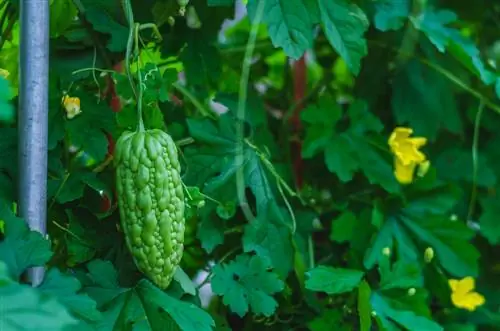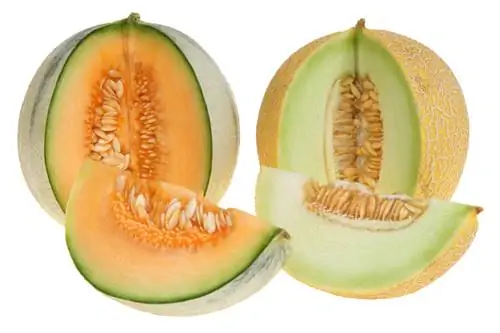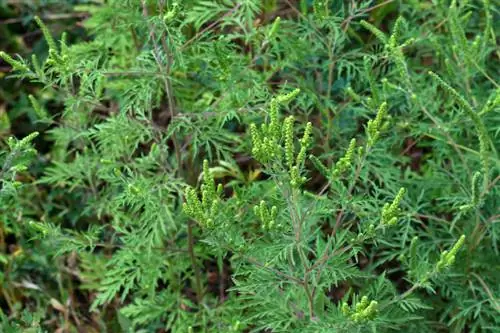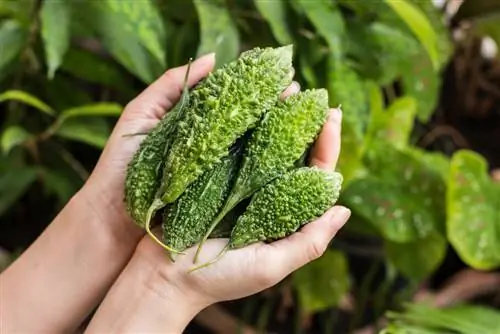- Author admin [email protected].
- Public 2023-12-16 16:46.
- Last modified 2025-06-01 06:02.
Read a green guide to bitter melon here. Informative information about the natural effect on diabetes and other complaints. Delicious recipes, lots of tips for planting and care.
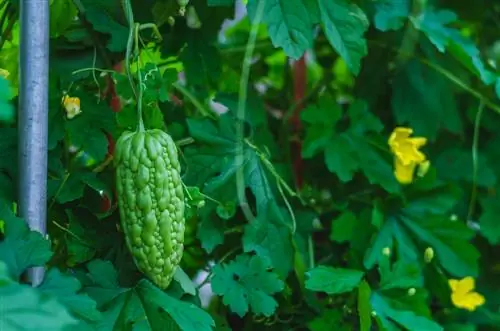
What is bitter melon and what is it used for?
The bitter melon (Momordica charantia) is a tropical climbing plant from the cucurbit family known for its bitter-tasting fruits. It has blood sugar-lowering, appetite-suppressing and anti-inflammatory properties and is used in traditional medicine and Asian cuisine.
Profile
- Scientific name: Momordica charantia
- Family: Cucurbitaceae
- Synonyms: bitter cucumber, balsam pear, balsam apple
- Type: herbaceous climbing plant
- Occurrence: tropical regions
- Flower: yellow, fragrant
- Leaf: palmate, lobed
- Fruit: Cranberries
- Taste: tart-bitter
- Harvest time: 3 weeks after flowering
- Winter hardiness: not hardy
- Uses: vegetables, medicinal plants
Bloom
Like most cucurbits, bitter melons thrive as monoecious, separate-sex plants. Male and female flowers grow on one individual. To the untrained eye, the two types of flowers can hardly be distinguished from each other. In June and July the yellow, five-petalled flowers unfold and smell pleasantly of vanilla.
Leaf
Decorative leaves can be admired on the up to 5 meter long tendrils of a bitter melon plant. The following features characterize the sheet:
- Shape: round-oval, palmately divided with 3 to 7 lobes
- Leaf stem: 3 cm to 7 cm long
- Leaf blade: 10 cm long, 12 cm wide
- Color: green
- Arrangement: alternate
Fruit
One to three weeks after flowering, the strong climbing plant bears the coveted fruits. These characteristics characterize a bitter melon:
- Shape: cucumber-like
- Size: 5 cm to 40 cm long
- Shell: leathery, wart-like knobs
- Color: green (unripe), later yellowish-orange (ripe)
- pulp: firm with cream-colored, later red, sticky seeds
- Taste: tart-bitter
- Special feature: ripe fruit bursts open and releases the seeds
The unripe, green fruits are harvested for a long storage time and the best enjoyment quality. Ripe, yellow-orange bitter gourds spoil the appetite with soft, cracked skin. In this phase, the bitter substances become overwhelming and the fruit is no longer suitable for consumption.
Video: The bitterest fruit in the world - made in Japan
Winter hardiness
Bitter cucumbers are grown as perennial climbing plants in the warm, humid climate of tropical regions. In our latitudes, the exotic pumpkin plants are not hardy and are cultivated as annuals.
Bitter melon effect
The peel, pulp and seeds contain various ingredients with pharmacological effects. Primarily it is charantin, a substance whose blood sugar-lowering effect has been known since the 15th century. In addition, the cucumber-like fruit is full of valuable vitamins, proteins and minerals, which underpin its status as a medicinal plant. The following table provides a selective insight into beneficial effects and lists potential side effects:
| Effect | Healing at | Side effects |
|---|---|---|
| blood sugar lowering | Diabetes type II early stage | hypoglycemic coma |
| appetite suppressant | Overweight | Seizures in children |
| anthelmintic | worm infestation | Nausea, vomiting |
| anti-inflammatory | Skin infection, hemorrhoids | Decrease in fertility |
| stomach strengthening | Upset stomach | Headache, fever |
| bilepromoting | Biliary problems | Miscarriage |
| antipyretic | Fever | Liver Damage |
Please note: The blood sugar-lowering effect, support in losing weight and other healing powers of bitter melon are based on the traditions of Asian folk medicine, various animal models and small-scale observations of humans. There are currently no well-founded clinical studies with medical evidence. For this reason, preparations based on bitter melon are considered dietary supplements. This applies equally to seed extract, tea, capsules and other dosage forms. The side effects mentioned result mainly from animal experiments.
Excursus
Extract more effective than tea and capsules
A recent study shows that aqueous bitter melon extract reduces blood sugar levels more significantly than tea or dry powder. The extract is made from 100 grams of chopped fruit, which is boiled in 200 milliliters of water to a volume of 100 milliliters. A clear hypoglycemic effect was observed in diabetes patients after just 3 weeks. The administration of tea or capsules did not achieve any significant reduction in blood sugar levels.
Bitter melon recipes
On Okinawa, the legendary 'Island of the Centenarians', bitter gourds have a regular place on the menu. We looked over the shoulders of Japanese chefs and discovered two delicious bitter melon recipes for you:
Reduce bitter substances
Regardless of the subsequent preparation, we recommend the following pre-treatment in advance in order to reduce the bitter substances in a fruit to a tasty level:
- Buy or harvest bitter melons in the unripe, green stage
- Wash fruit thoroughly
- Choose to peel roughly or use unpeeled
- Pick fruit whole or cut into pieces in s alt
After 15 minutes in the s alt bath, most of the bitter substances have dissolved nicely. Now rinse off the s alt and concentrate on further preparation.
Fried bitter melons with egg
One serving requires these ingredients: 1 bitter melon, 2 tablespoons sunflower oil, 1 egg, 3 cloves of garlic, 1 pinch of s alt and 1 drop of soy sauce.
- Halve the bitter melon lengthwise
- Remove pulp and seeds with a spoon
- Cut fruit into thin slices
- Peel garlic cloves and chop finely
- Fry garlic in hot oil in a pan
- Add bitter melon slices, fry until translucent, season with soy sauce and s alt
- Break the egg, pour over the vegetables, let it simmer on a low heat
Serve the dish in style with shokupan or simply with a crusty baguette.
Goya Champuru - bitter melon stew
To prepare 2 servings, have these ingredients ready: 1 bitter gourd, 1 block of dried tofu, 100 grams of thinly sliced pork, 2 tbsp soy sauce, 2 tbsp rice wine, 2 tbsp cooking oil, 1/2 tsp s alt, 2 Eggs.
- Halve the fruit, scrape it and cut it into slices
- Fry the pork in 1 tablespoon of hot oil, season with s alt
- Add the tofu piece by piece and sauté until tender brown
- Set the meat and tofu mixture aside in a bowl
- Add 1 tbsp oil to the pan
- Fry bitter melon slices, add meat and tofu mixture
- Whisk eggs with soy sauce and rice wine, pour over the contents of the pan and let set
Vegetarians swap the pork for chopped vegetables such as carrots, beans and onions. We recommend rice as a side dish.
Planting bitter melon
In hobby gardens, frost-sensitive bitter melons are cultivated as annuals. It makes sense to grow seeds on a warm windowsill. By the start of the planting season in early/mid-May, the early young plants are prepared with a considerable growth lead for optimal harvest yield. How to do it right:
Growing from seeds
Certified seeds are available in specialized online shops, in Asian stores and, rarely, in local stores. Alternatively, sacrifice a bitter melon and let it ripen until the rind turns yellow-orange, splits open and reveals the red seeds. The best time for sowing is in March and April. This is how it works:
- Soak seeds in lukewarm water or chamomile tea for 6 to 12 hours before sowing
- Medium-sized cultivation pots filled with a mix of vegetable soil and coconut substrate
- Moisten the substrate with rainwater or stale tap water
- Sow 2 seeds 1 cm deep in each pot
- Put a transparent hood or plastic bag over the containers
- Place seed containers in a bright place at an ideal temperature of 20° to 23° Celsius
Keep the potting soil slightly moist. The cover creates a warm, humid microclimate that has a beneficial effect on germination. After two weeks the first seedlings will sprout and the hood can be removed. With a growth height of 15 centimeters, repot the young plants into larger pots with loose, nutrient-rich soil.
Plants
Ideally, tropical bitter melons, like cucumbers, are grown in a greenhouse. Balcony gardeners plant a balsam pear in a pot. Outdoor cultivation is reserved for hobby gardeners in mild wine regions. You can read important planting tips in the following overview:
- Location: sunny, warm, sheltered from the wind
- Soil: fertile, deep, with good water holding capacity without the risk of waterlogging
- Bucket substrate: nutrient-rich, organically pre-fertilized, coconut soil as a peat substitute, lava granules as drainage
- Planting distance: 30 cm to 40 cm (outdoors and greenhouse)
- Extra tip: mulch with nettle leaves for additional nutrients and fewer weeds
Planting with a trellis is mandatory. In the greenhouse you can tie the meter-long tendrils to strings. For a pot or planter, we recommend a trellis or a decorative pyramid. Various solutions have proven to work well outdoors, such as bamboo sticks connected to form a teepee or grids between two wooden posts. The bitter melon climbs up a pergola on the south wall of the house in no time and becomes useful as an annual green facade.
Care for bitter melon
The care of bitter melon plants is characterized by high water and nutrient requirements. In view of the rapid growth and a harvest time three weeks after flowering, we recommend adding organic liquid fertilizer instead of compost. There is simply not enough time for soil organisms to convert compost soil into nutrients available to plants. Don't miss the following care tips:
- Watering: water in the bed and pot as soon as the soil on the surface has dried
- Fertilizing: fertilize weekly with liquid vegetable fertilizer, worm tea, nettle or comfrey manure
- Cleaning out: remove wilted, male flowers without visible fruit set
- Cutting: cut off barren or excess side shoots
Diseases and pests are rarely reported on bitter melon plants. The many bitter substances in leaves, shoots and fruits deter most pathogens. A generous planting distance effectively prevents mildew infestation. You can fight bold aphids with the tried and tested soap solution.
FAQ
Can you eat bitter melon raw?
Eating bitter melon raw is strongly discouraged. If left uncooked and without prior treatment in a s alt bath, the bitter substances they contain can cause a severe stomach upset. Furthermore, the seeds are not suitable for consumption.
What is the effect of bitter melon on blood pressure?
Bitter melon has made a name for itself in natural medicine in many countries as a medicinal plant for type 2 diabetes, fever, worm infestations, infections, headaches and obesity. On the Caribbean island of Trinidad, bitter gourds are also taken against high blood pressure. European manufacturers of nutritional supplements have taken up this aspect and offer tea or capsules with bitter melon extract as a natural remedy for high blood pressure. Considering possible side effects, such as cardiac arrhythmias, please consult an expert or your family doctor before taking.
Should you peel bitter melon?
If you want to reduce the bitter substances before preparation, you can roughly peel the fruit, cut it into slices, s alt it generously and rinse it after a quarter of an hour. In Asia, the peel of green, unripe bitter gourds is often eaten because it has a delicate consistency.

